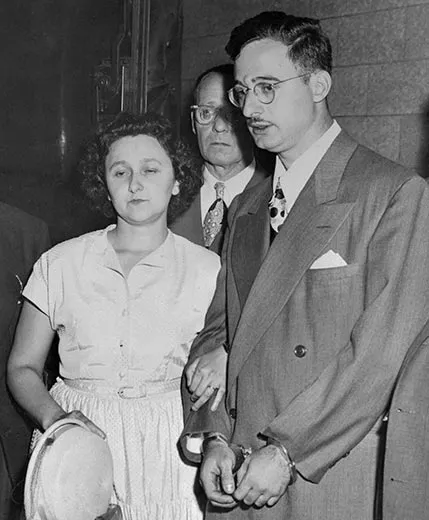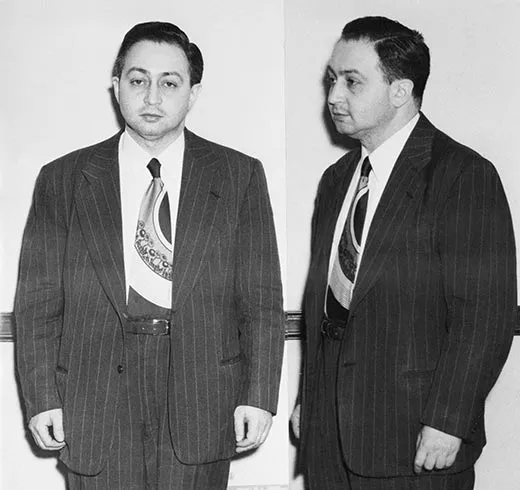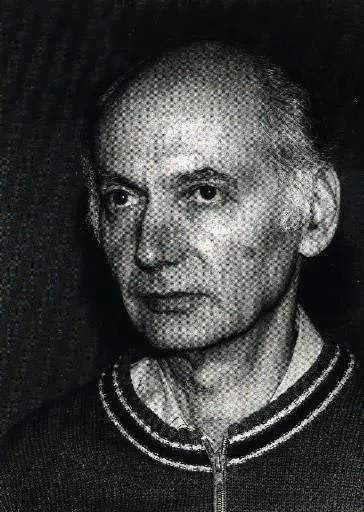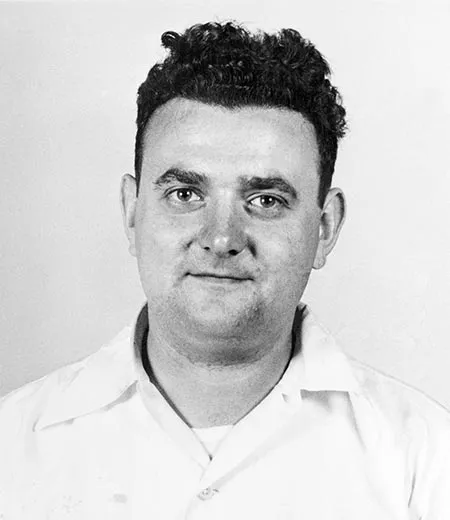Spies Who Spilled Atomic Bomb Secrets
As part of the Soviet Union’s spy ring, these Americans and Britons leveraged their access to military secrets to help Russia become a nuclear power
/https://tf-cmsv2-smithsonianmag-media.s3.amazonaws.com/filer/Klaus-Fuchs-David-Greenglass-atomic-spies-631.jpg)
Despite being an ally during World War II, the Soviet Union launched an all-out espionage effort to uncover the military and defense secrets of the United States and Britain in the 1940s. Within days of Britain's highly classified decision in 1941 to begin research on building an atomic bomb, an informant in the British civil service notified the Soviets. As the top-secret plan to build the bomb, called the Manhattan Project, took shape in the United States, the Soviet spy ring got wind of it before the FBI knew of the secret program's existence. Barely four years after the United States dropped two atomic bombs on Japan in August 1945, the Soviet Union detonated its own in August 1949, much sooner that expected.
The Soviets did not lack for available recruits for spying, says John Earl Haynes, espionage historian and author of Early Cold War Spies. What drove these college-educated Americans and Britons to sell their nations' atomic secrets? Some were ideologically motivated, enamored of communist beliefs, explains Haynes. Others were motivated by the notion of nuclear parity; one way to prevent a nuclear war, they reasoned, was to make sure that no nation had a monopoly on that awesome power.
For many years, the depth of Soviet spying was unknown. The big breakthrough began in 1946 when the United States, working with Britain, deciphered the code Moscow used to send its telegraph cables. Venona, as the decoding project was named, remained an official secret until it was declassified in 1995. Because government authorities did not want to reveal that they had cracked the Russian code, Venona evidence could not be used in court, but it could trigger investigations and surveillance hoping to nail suspects in the act of spying or extract a confession from them. As Venona decryption improved in the late 1940s and early 1950s, it blew the cover of several spies.
Investigations resulted in the execution or imprisonment of a dozen or more people who had passed atomic secrets to the Soviets, but no one knows how many spies got away. Here are some of the ones we know about:
John Cairncross
Considered the first atomic spy, John Cairncross was eventually identified as one of the Cambridge Five, a group of upper-middle class young men who had met at Cambridge University in the 1930s, became passionate communists and eventually Soviet spies during World War II and into the 1950s. In his position as secretary to the chairman of Britain's scientific advisory committee, Cairncross gained access to a high-level report in the fall of 1941 that confirmed the feasibility of a uranium bomb. He promptly leaked the information to Moscow agents. In 1951 when British agents closed in on other members of the Cambridge spy ring, Cairncross was interrogated after documents in his handwriting were discovered in a suspect's apartment.
Ultimately he was not charged, and according to some reports, asked by British officials to resign and keep quiet. He moved to the United States where he taught French literature at Northwestern University. In 1964, questioned again, he admitted to spying for Russia against Germany in WWII, but denied giving any information harmful to Britain. He went to work for the United Nations Food and Agriculture Organization in Rome and later lived in France. Cairncross returned to England a few months before his death in 1995, and went to his grave insisting that the information he gave Moscow was "relatively innocuous." In the late 1990s when Russia under its new democracy made public its KGB files from the last 70 years, the documents revealed that Cairncross was indeed the agent who provided "highly secret documentation [of] the British Government to organise and develop the work on atomic energy."
Klaus Fuchs
Dubbed the most important atomic spy in history, Klaus Fuchs was a primary physicist on the Manhattan Project and a lead scientist at Britain's nuclear facility by 1949. Just weeks after the Soviets exploded their atomic bomb in August 1949, a Venona decryption of a 1944 message revealed that information describing important scientific processes related to construction of the A-bomb had been sent from the United Sates to Moscow. FBI agents identified Klaus Fuchs as the author.
Born in Germany in 1911, Fuchs joined the Communist Party as student, and fled to England during the rise of Nazism in 1933. Attending Bristol and Edinburgh universities, he excelled in physics. Because he was a German national he was interned for several months in Canada but returned and cleared to work on atomic research in England. By the time he became a British citizen in 1942, he had already contacted the Soviet Embassy in London and volunteered his services as a spy. He was transferred to the Los Alamos lab and began handing over detailed information about the bomb construction, including sketches and dimensions. When he returned to England in 1946, he went to work at Britain's nuclear research facility, and passed information on creating a hydrogen bomb to the Soviet Union. In December 1949, authorities, alerted by the Venona cable, questioned him. In a matter of few weeks, Fuchs confessed all. He was tried and sentenced to 14 years in prison. After serving nine years he was released to East Germany, where he resumed work as a scientist. He died in 1988.
Theodore Hall
For nearly half a century Fuchs was thought to have been the most significant spy at Los Alamos, but the secrets Ted Hall divulged to the Soviets preceded Fuchs and were also very critical. A Harvard graduate at age 18, Hall, at 19, was the youngest scientist on the Manhattan project in 1944. Unlike Fuchs and the Rosenbergs, he got away with his misdeeds. Hall worked on experiments for the bomb that was dropped on Nagasaki, the same type that the Soviet detonated in 1949. As a boy, Hall witnessed his family suffer during the Great Depression and his brother advised him to drop the family name Holtzberg to escape anti-Semitism. Such harsh realities of the American system affected young Hall, who joined the Marxist John Reed Club upon arrival at Harvard. When he was recruited to work at Los Alamos, he was haunted, he explained decades later, by thoughts of how to spare humanity the devastation of nuclear power. Finally, on leave in New York in October 1944, he decided to equalize the playing field, contacted the Soviets and volunteered to keep them apprised of the bomb research.
With the help of his courier and Harvard colleague, Saville Sax (a fervent communist and aspiring writer), Hall used coded references to Walt Whitman's Leaves of Grass to set up meeting times. In December 1944 Hall delivered what was probably the first atomic secret from Los Alamos, an update on the creation of the plutonium bomb. In the fall of 1946 he enrolled in University of Chicago, and was working on his PhD in 1950 when the FBI turned its spotlight on him. His real name had surfaced in a decrypted message. But Fuch's courier, Harry Gold who was already in prison, could not identify him as the man, other than Fuchs, that he had collected secrets from. Hall never went to trial. After a career in radiobiology, he moved to Great Britain and worked as a biophysicist until his retirement. When the 1995 Venona declassifications confirmed his spying from five decades earlier, he explained his motivations in a written statement: "It seemed to me that an American monopoly was dangerous and should be prevented. I was not the only scientist to take that view." He died in 1999 at age 74.
Harry Gold, David Greenglass, Ethel and Julius Rosenberg
When Klaus Fuchs confessed in January 1950, his revelations would lead to the arrest of the man to whom he had passed the atomic secrets in New Mexico, even though the courier had used an alias. Harry Gold, a 39-year-old Philadelphia chemist had been ferrying stolen information, mainly from American industries, to the Soviets since 1935. When the FBI found a map of Santa Fe in Gold's home, he panicked and told all. Convicted in 1951 and sentenced to 30 years, his confession put authorities on the trail to other spies, most famously Julius and Ethel Rosenberg and Ethel's brother David Greenglass. After being drafted into the Army, David Greenglass was transferred to Los Alamos in 1944, where he worked as a machinist. Encouraged by his brother-in-law, Julius Rosenberg, a New York engineer and devoted communist who actively recruited his friends to spy, Greenglass soon began supplying information from Los Alamos.
In addition to Fuchs and Hall, Greenglass was the third mole at the Manhattan Project, although they did not know of each other's covert work. In 1950 as the atomic spy network unraveled, Gold, who had picked up material from Greenglass in New Mexico, positively identified Greenglass as his contact. That identification turned the investigation away from Ted Hall, who initially was a suspect. Greenglass confessed, implicating his wife, his sister and his brother-in law. To lessen their punishment, his wife came forward, providing details of her husband and her in-laws' involvement. She and Greenglass had given Julius Rosenberg handwritten documents and drawings of the bomb, and Rosenberg had devised a cut-up Jell-O box as a signal. The Venona decryptions also corroborated the extent of Julius Rosenberg's spy ring, though they were not made public. The Rosenbergs, however, denied everything and adamantly refused to name names or answer many questions. They were found guilty, sentenced to death in 1951 and despite pleas for clemency, executed on June 19, 1953 in the electric chair at Sing-Sing prison in New York. Because they chose to cooperate, Greenglass received 15 years and his wife was never formally charged.
Lona Cohen
Lona Cohen and her husband Morris were American communists who made a career of industrial espionage for the Soviets. But in August 1945, she picked up some Manhattan Project secrets from Ted Hall and smuggled them past security in a tissue box. Soon after the United States dropped the atomic bombs on Japan, authorities ramped up security for the scientists in the Los Alamos region. After rendezvousing with Hall in Albuquerque and stuffing Hall's sketch and documents under the tissues, Lona discovered that agents were searching and questioning train passengers. Posing as a hapless woman who had misplaced her ticket, she successfully distracted police, who handed her the "forgotten" box of tissues, whose secret papers she spirited to her Soviet handlers.
When the investigations and trials of the early 1950s got scorchingly close, the Cohens fled to Moscow. In 1961 the couple, under aliases, resurfaced in a London suburb, living as Canadian antiquarian booksellers, a cover for their continued spying. Their spy paraphernalia included a radio transmitter stashed under the refrigerator, fake passports, and antique books concealing stolen information. At their trial the Cohens refused to spill their secrets, once again thwarting any lead to Ted Hall's spying. They received 20 years, but in 1969 were released in exchange for Britons incarcerated in the Soviet Union. Both received that country's highest hero award before their deaths in the 1990s.




